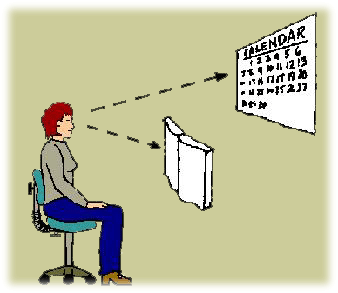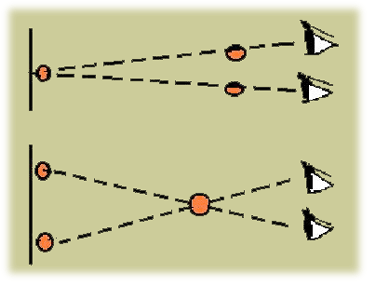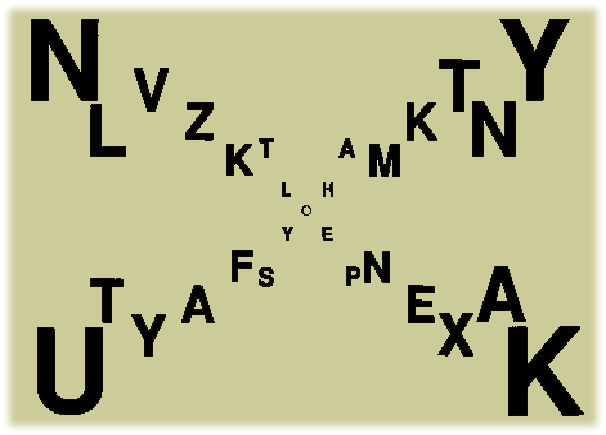Step 1) Warm your hands by rubbing them together. Then, with your eyes shut, cup your hands around your eyes. Keep all light out, but be sure not to apply pressure to your eyes.

Step 2) Breathe slowly and take deep breaths. Imagine yourself in your chosen daydream, such as a tropical beach, mountain getaway, etc. It is a beautiful day, and you don't have a care in the world. You can feel the sun warm your skin, as the palm trees sway in the breeze. Enjoy the fantasy and visualize as much detail as you can.
Duration/Frequency: One to five minutes each break, several times throughout the day.

Refocussing Exercise
Purpose: To develop more efficient shifts in focusing between near and far areas.
For the following exercises use both eyes, and wear eye glasses if you wear them regularly.
Required Materials: Wall calendar, book or magazine.
Step 1) Hang a calendar far enough away that the numbers on it are barely legible.
Step 2) Position your reading material about 15 inches away.

Step 3) Quickly read the first 4 characters on the top line of the calendar across the room. Then read the first line of the magazine. Repeat until you can refocus between calandar and magazine easily.
Step 4) Now, move the magazine to within six inches of your eyes. Repeat the previous task until refocussing at this distance becomes comfortable.
Step 5) Vary steps 3 through 4 as follows: a) read numbers on the calendar right to left, b) increase the quanity of numbers read, c) read numbers vertically, etc. GOAL: To refocus as quickly as possible.
Duration/Frequency: 3 one-minute cycles per day.

Eye String Exercise
Purpose: To teach you to coordinate both eyes simultaneously, especially while refocussing.
Required Materials: Eight foot piece of string with a colored bead 13" from one end.
For the following exercises, wear glasses if normally worn for viewing objects 8-12 feet away.
Step 1) Fasten the string to a stationary object (such as a wall) at eye level. Hold the other end of the string against your nose. The colored bead on the string should be 10 inches from your eyes and the other end of the string should be 8 feet away. Stretch the string tightly.
Step 2) As you focus on the far end of the string, you should see two strings emerging from the sides of your head, converging at the strings end.

Step 3) Seeing only one string indicates suppression or non-use of one eye. In order to see two strings the following procedure must be followed: Take your hand and cover one eye. Focus on the end of the string. Shift your hand from one eye to the other and focus on the end of the string again. Periodically look for the "V" with both eyes open.
Step 4) When a "V" can be seen, look at the "V" and then look at the colored bead. You should now see an "X" meeting at the bead and continuing through the bead.
Step 5) As training proceeds the length of the string may be increased from 8 feet to 12 feet and several different colored beads may be added. This will induce further divergence of the eyes.
Frequency/Duration: Three one-minute cycles per day.

Thumb Rotations
Purpose: This exercise helps improve your eye control.
Step 1) Stand relaxed.
Step 2) Cover one eye with your hand.
Step 3) Hold the other hand directly in front of your nose, elbow straight, fingers gently clenched, and thumb pointing up. This point is called the starting point. Look at your thumbnail.

Step 4) Move your arm upward, then outward and downward to a point that is level with the nose. Then move it to the starting point again. The thumb should have moved in an outline of a quarter circle.
Step 5) Focus on your thumnail throughout the entire motion.
Step 6) Repeat with the other eye.
*Move only your arm and eyeball.
Frequency/Duration: Six repetitions in each direction, once daily.

Macdonald Form Field Card
Required Material: Form Field Card (print hard copy below by highlighting the "field card" below and slecting File > Print > selection from your tab bar).
For the following exercises wear prescription eyeglasses only if necessary to maintain clear focus on central fixation point.
Step 1) Hold card about 15" away from eyes.
Step 2) Focus on center of card.
Step 3) Identify as many letters in the periphery as possible, while maintaining your focus on the card's center.
Frequency/Duration: Three times a week for two minutes.



